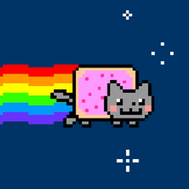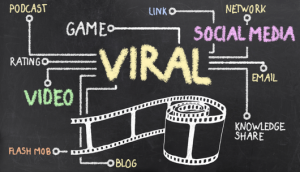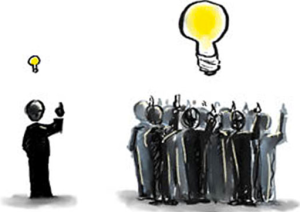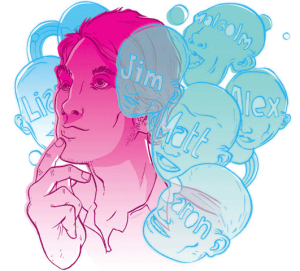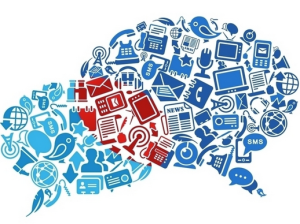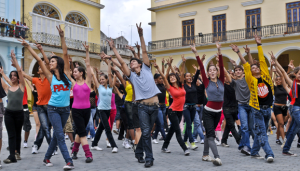 A flash mob is an organized group of people who assemble in a public place to create a large scale, spontaneous performance to entertain the general public. Flash mob performances can include song, dance, acting, and making/breaking records.
A flash mob is an organized group of people who assemble in a public place to create a large scale, spontaneous performance to entertain the general public. Flash mob performances can include song, dance, acting, and making/breaking records.
Flash mobs are a type of performing art. While they started as an apolitical act to poke fun at societal conformity, they have now taken a life of their own.
Bill Wasik is credited with using the term ‘flash mob’ in 2003. Wasik attributes the origins of flash mobs with a “playful social experiment meant to encourage spontaneity and big gatherings to temporarily take over commercial and public areas simply to show that they could”.
 The term ‘flash mob’ was added to the 11th edition of the Concise Oxford English Dictionary in 2004. It was defined as an “unusual and pointless act”. This definition separated it from different forms of smart mobs like public performances, protests, and public gatherings. It was later added to Webster’s New Millennium Dictionary of English as “a group of people who organize on the Internet and then quickly assemble in a public place, do something bizarre, and disperse.” The media, however, continued to use ‘flash mob’ as a way to describe all smart mobs (including political protests), DOS attacks, collaborative demonstrations, and promotional appearances. But now the term ‘flash mob’ is used mostly in reference to public performance art.
The term ‘flash mob’ was added to the 11th edition of the Concise Oxford English Dictionary in 2004. It was defined as an “unusual and pointless act”. This definition separated it from different forms of smart mobs like public performances, protests, and public gatherings. It was later added to Webster’s New Millennium Dictionary of English as “a group of people who organize on the Internet and then quickly assemble in a public place, do something bizarre, and disperse.” The media, however, continued to use ‘flash mob’ as a way to describe all smart mobs (including political protests), DOS attacks, collaborative demonstrations, and promotional appearances. But now the term ‘flash mob’ is used mostly in reference to public performance art.
Organizing a lot of people on a large scale can be difficult. Some flash mobs have been very successful, and there have been some that you never heard about because they tanked. You want to organize a rewarding performance for both those participating and observing.
How to organize a flash mob:
- Understand the purpose of the flash mob
- Decide what you are going to be doing for your flash mob occasion
- Watch pervious flash mobs on YouTube
- Organize your flash mob
- Provide clear instructions for all participants
- Arrange props or costumes as needed
- Know the limitations of your location
- Organize quality videography of your flash mob
- Perform
- Finish as if nothing ever happened
A flash mob is about the performance and its entertainment value. While there might be harmless confusion in the beginning it should give way to something the audience can immediately understand, follow along with, and response to.
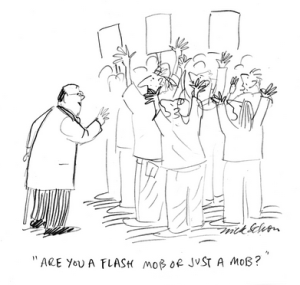 A flash mob is NOT a:
A flash mob is NOT a:
- publicity stunt
- marketing venture
- political act
- riot/crime spree
- guerrilla advertising
It’s all about spontaneity with an element of entertainment/satire for all those involved. No strings attached! The motive should not need to be explained to the observers. [A flash mob is NOT violent or damaging in anyway.
Some tips about flash mobs:
- Try to keep it a surprise!
- Beware of local laws about public space/gatherings.
- Not all people have to be doing the same action.
- Flash mobs don’t need to be precise.
- Have fun!
Some warnings about flash mobs:
- Some people don’t have a sense of humor and will be offended with anything you do.
- If you are in a crowded/well-trafficked area be aware of your surroundings; keep it safe!
- Be wise in your choice of location.
- You might get stopped by officials or police so be prepared to follow directions and disband; don’t be argumentative or confrontations.
- Know local laws about large gatherings in your performance space.
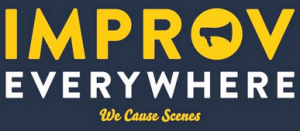 A wonderful example of successful, harmless flash mobs is the comedic performance art group, Improv Everywhere. Formed in 2001 by Charlie Todd, the group carries out “missions” in public places to cause “chaos and joy” in New York City. The group events sometimes just a few actors while others use hundreds or thousands of “undercover agents”. While the group does not identify their work with the term ‘flash mob’ (since they were created two years before the trend), their performances can be labeled as such and greatly mimic the definition of flash mobs.
A wonderful example of successful, harmless flash mobs is the comedic performance art group, Improv Everywhere. Formed in 2001 by Charlie Todd, the group carries out “missions” in public places to cause “chaos and joy” in New York City. The group events sometimes just a few actors while others use hundreds or thousands of “undercover agents”. While the group does not identify their work with the term ‘flash mob’ (since they were created two years before the trend), their performances can be labeled as such and greatly mimic the definition of flash mobs.
Some great examples of Improv Everywhere’s work includes: “The Mute Button”, “Suicide Jumper”, “Where’s Rob?”, and “No Pants Subway Ride 2014”.
The concept of citizen journalism has formed upon the basis of the public “playing an active role in the process of collecting, reporting, analyzing, and disseminating news and information”. And, now in the age of mobile phones and smartphones that have photographic capabilities, citizen journalism can be taken to a whole other level.
technology we have to give us the power we need to ensure that justice and exercise the right. We have the responsibility to rightly use technology to regulate journalism.






